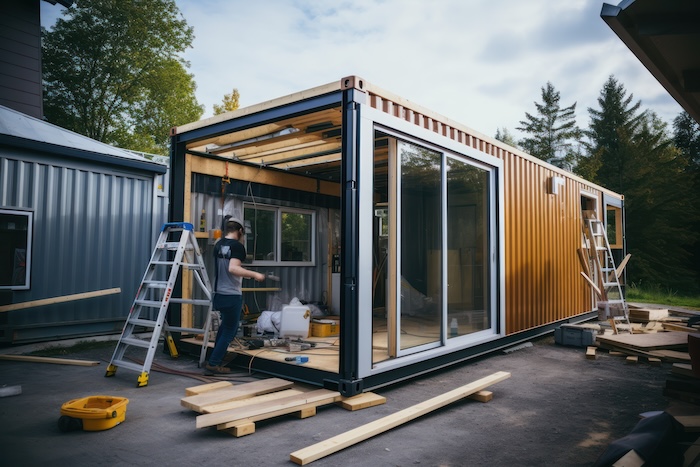Table of Contents

In recent years, the innovative use of shipping containers has redefined the boundaries of construction. These sturdy structures are increasingly favored for their functionality and adaptability in building diverse spaces. This trend reflects a shift toward more sustainable and creative architectural practices.
Initially designed for transporting goods, shipping containers have transcended their original purpose. Today, they are transformed into dynamic building materials, marking a significant shift in construction methodologies.
Types Of Containers And Their Features
Shipping containers, diverse in form and function, are integral to modern construction. Their variety caters to a myriad of architectural needs, redefining building practices.
1. Standard Containers
Standard containers, measuring 20 feet and 40 feet, are the most widely used in construction. Their uniform dimensions make them ideal for modular designs. These containers offer a balance of space and practicality, making them suitable for a range of projects, from homes to offices. Their size is perfect for easy transport and setup, which simplifies the building process.
Their popularity in the construction sector stems from their convenience and efficiency in creating functional, modern spaces. For more details on standard shipping containers, explore resources in shipping container sales that provide in-depth information on their specifications and uses.
2. High-Cube Containers
High-cube containers stand out in the shipping container family for their extra height, measuring one foot taller than standard containers. This additional space makes them highly sought after for construction projects requiring more vertical room.
Whether it’s for a living space with a loftier feel or an office with ample headroom, high-cube containers offer a versatile solution. Their standard length and width dimensions remain consistent with regular containers, ensuring ease of transport and integration into various construction designs.
3. Open-Top Containers
Open-top containers are specialized shipping containers designed without a fixed roof. This unique feature makes them ideal for transporting or storing oversized items, such as machinery or tall equipment, that wouldn’t fit in standard containers.
They are also useful in construction projects where height is a factor, providing an adaptable and accessible space. These containers typically come with a removable tarpaulin roof, allowing for easy loading and unloading of goods from above, adding to their versatility in various applications.
4. Flat-Rack Containers
Flat-rack containers accommodate objects like large machinery, vehicles, and oversized construction materials. Their open design allows for the transport of items that wouldn’t fit in standard containers.
In construction, they’re used in creating broad platforms for structures such as bridges, stages, or temporary housing units. These containers provide a sturdy base or framework, supporting the construction of larger, more complex structures. Their use demonstrates creative problem-solving in modern architectural designs.
Durability is a cornerstone of these containers, withstanding harsh conditions and time. Their robust steel composition ensures longevity. Moreover, their adaptability allows architects to mold them into innovative, functional spaces, challenging conventional construction norms.
Applications In Construction
In modern construction, shipping containers are increasingly popular for their unique contributions to various project types.
In residential projects, these containers are transformed into trendy, cost-effective homes. Their modular design allows for creative layouts, from compact single units to expansive multi-container residences.
Commercially, they serve as unique office spaces, pop-up shops, and restaurants. Their portability and ease of modification make them ideal for businesses seeking a modern, industrial aesthetic.
For public projects, shipping containers offer practical solutions. They are repurposed as emergency housing, classrooms, and community centers. Their quick deployment capability is invaluable in responding to urgent needs.
These applications showcase the remarkable flexibility of shipping containers in meeting diverse construction requirements.
Benefits Of Using Shipping Containers
Shipping containers bring distinctive advantages to construction, revolutionizing how structures are built and designed.
- Cost-Effectiveness: Shipping containers provide a cost-efficient alternative to traditional building materials. Their reuse in construction helps significantly reduce material expenses.
- Sustainability: Utilizing used shipping containers is a form of upcycling, which greatly reduces environmental waste. This practice aligns with eco-friendly building strategies, promoting a greener approach to construction.
- Speed Of Construction: The prefabricated nature of shipping containers accelerates construction timelines. Projects can be completed faster, as containers are ready-made structures that require minimal assembly.
- Architectural Flexibility: Containers offer immense flexibility in design. They can be easily modified, stacked, and rearranged, allowing for innovative and bespoke architectural solutions.
- Design Aesthetics: With their modern and industrial look, shipping containers appeal to contemporary design sensibilities. They provide a unique aesthetic that stands out in both urban and rural settings.
Incorporating shipping containers into construction projects opens up new possibilities in design, efficiency, and sustainability.
Challenges And Solutions
While shipping containers are versatile, they pose challenges like insulation, structural integrity, and compliance with building codes. Proper insulation is crucial for comfortable living spaces, especially in extreme climates. Structural modifications, such as cutting windows or doors, require reinforcement to maintain integrity. Adhering to local building codes is essential for safety and legality, often necessitating expert consultation.
Innovative design solutions are key to overcoming these challenges. Architects and engineers are developing new methods for integrating insulation without compromising space. Creative reinforcement techniques ensure structural safety. These advancements, coupled with a deep understanding of building regulations, are making container-based construction more accessible and reliable.
Conclusion
Shipping containers in construction showcases practicality and creativity. Their use opens up new possibilities in building design and efficiency. This trend highlights the industry’s adaptability and commitment to sustainable practices. As construction evolves, shipping containers will likely play a crucial role in shaping modern architecture.
